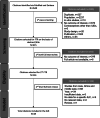Discontinuation rates of intrauterine contraception due to unfavourable bleeding: a systematic review
- PMID: 35313863
- PMCID: PMC8939098
- DOI: 10.1186/s12905-022-01657-6
Discontinuation rates of intrauterine contraception due to unfavourable bleeding: a systematic review
Abstract
Objective: Levonorgestrel-releasing intrauterine devices (LNG-IUDs) and copper intrauterine devices (Cu-IUDs) offer long-acting contraception; however, some women may discontinue use within the first year due to bleeding pattern changes, limiting their potential. This systematic literature review investigated whether differences in bleeding profiles influence continuation rates in women in America, Europe and Australia.
Methods: Searches performed in PubMed and Embase were screened to identify publications describing bleeding patterns and rates of early IUC removal/discontinuation or continuation, descriptions of bleeding patterns, reasons for discontinuation, and patient satisfaction, acceptability and tolerability for LNG-IUDs and Cu-IUDs published between January 2010 and December 2019. The results were further restricted to capture citations related to 'Humans' and 'Females'. The review was limited to studies published from 2010 onwards, as changing attitudes over time mean that results of studies performed before this date may not be generalizable to current practice.
Results: Forty-eight publications describing 41 studies performed principally in the USA (n = 17) and Europe (n = 13) were identified. Publications describing bleeding patterns in LNG-IUD users (n = 11) consistently observed a reduction in bleeding in most women, whereas two of three studies in Cu-IUD users reported heavy bleeding in approximately 40% of patients. Rates of discontinuation for both devices ranged widely and may be as high as 50% but were lower for LNG-IUDs versus Cu-IUDs. Discontinuation rates due to bleeding were consistently higher for Cu-IUDs versus LNG-IUDs.
Conclusions: Bleeding is a common reason for discontinuation of Cu-IUDs and LNG-IUDs. The more favourable bleeding pattern observed in LNG-IUD users may be associated with a lower rate of early discontinuation of LNG-IUDs versus Cu-IUDs.
Keywords: Contraception; Discontinuation; Intrauterine device; Menstrual bleeding; Satisfaction.
© 2022. The Author(s).
Conflict of interest statement
DC has received grants and personal fees from Bayer AG, Merck and Allergan. RC is an employee of Accuscript Consultancy, Ludhiana, Punjab, India. RH is an employee of Accuscript Consultancy, Reading, Berkshire, UK. ST has served on scientific advisory boards for Allergan and Bayer AG. MM is an employee of Bayer AG, Berlin, Germany. Accuscript Consultancy was paid a fee for the conduct of the initial literature search and analysis.
Figures



Similar articles
-
Menstrual characteristics and ultrasonographic uterine cavity measurements predict bleeding and pain in nulligravid women using intrauterine contraception.Hum Reprod. 2015 Jul;30(7):1580-8. doi: 10.1093/humrep/dev102. Epub 2015 May 19. Hum Reprod. 2015. PMID: 25990577
-
Detailed analysis of menstrual bleeding patterns after postmenstrual and postabortal insertion of a copper IUD or a levonorgestrel-releasing intrauterine system.Contraception. 1996 Oct;54(4):201-8. doi: 10.1016/s0010-7824(96)00189-8. Contraception. 1996. PMID: 8922872 Clinical Trial.
-
Contraception with levonorgestrel-releasing intrauterine system versus copper intrauterine device: a meta-analysis of randomized controlled trials.EClinicalMedicine. 2024 Nov 12;78:102926. doi: 10.1016/j.eclinm.2024.102926. eCollection 2024 Dec. EClinicalMedicine. 2024. PMID: 39610901 Free PMC article.
-
An evaluation of the levonorgestrel-releasing IUD: its advantages and disadvantages when compared to the copper-releasing IUDs.Contraception. 1991 Dec;44(6):573-88. doi: 10.1016/0010-7824(91)90078-t. Contraception. 1991. PMID: 1773615 Review.
-
Levonorgestrel-releasing IUD as a method of contraception with therapeutic properties.Contraception. 1995 Nov;52(5):269-76. doi: 10.1016/0010-7824(95)00210-2. Contraception. 1995. PMID: 8585882 Review.
Cited by
-
Contraception Choice for Female Endurance Athletes: What's Sport Got to Do With It? A Cross-Sectional Survey.Sports Med. 2024 Dec;54(12):3181-3197. doi: 10.1007/s40279-024-02078-1. Epub 2024 Sep 1. Sports Med. 2024. PMID: 39217588 Free PMC article.
-
Comparative analysis of the clinical efficacy of conservative treatment for adenomyosis using traditional Chinese medicine and Western medicine.J Health Popul Nutr. 2025 Apr 13;44(1):116. doi: 10.1186/s41043-025-00852-z. J Health Popul Nutr. 2025. PMID: 40223114 Free PMC article.
-
Continuation of Reversible Contraception Following Enrollment in the Zika Contraception Access Network (Z-CAN) in Puerto Rico, 2016-2020.Stud Fam Plann. 2024 Jun;55(2):105-125. doi: 10.1111/sifp.12262. Epub 2024 Apr 24. Stud Fam Plann. 2024. PMID: 38659169 Free PMC article.
-
Perceptions of women and their partners on postabortion intrauterine contraception: A qualitative study in central Uganda.PLoS One. 2025 Jun 25;20(6):e0316982. doi: 10.1371/journal.pone.0316982. eCollection 2025. PLoS One. 2025. PMID: 40560973 Free PMC article.
-
Clinical Efficacy of Dienogest versus Levonorgestrel-Releasing Intrauterine System for Adenomyosis.Evid Based Complement Alternat Med. 2022 Jul 15;2022:1995472. doi: 10.1155/2022/1995472. eCollection 2022. Evid Based Complement Alternat Med. 2022. Retraction in: Evid Based Complement Alternat Med. 2023 Jun 21;2023:9856568. doi: 10.1155/2023/9856568. PMID: 35873621 Free PMC article. Retracted.
References
-
- Blumenthal PD, Voedisch A, Gemzell-Danielsson K. Strategies to prevent unintended pregnancy: increasing use of long-acting reversible contraception. Hum Reprod Update. 2011;17(1):121–137. - PubMed
-
- U.S. Selected Practice Recommendations for Contraceptive Use, 2013: adapted from the World Health Organization selected practice recommendations for contraceptive use, 2nd edition. MMWR Recomm Rep. 2013;62:1–60. - PubMed
-
- Ortiz ME, Croxatto HB. Copper-T intrauterine device and levonorgestrel intrauterine system: biological bases of their mechanism of action. Contraception. 2007;75(6 Suppl):S16–30. - PubMed
-
- Bayer HealthCare Pharmaceuticals Inc. Mirena Prescribing Information. October 2009. https://www.accessdata.fda.gov/drugsatfda_docs/label/2009/021225s027lbl.pdf. Accessed Jan 2021.
Publication types
MeSH terms
Substances
LinkOut - more resources
Full Text Sources

